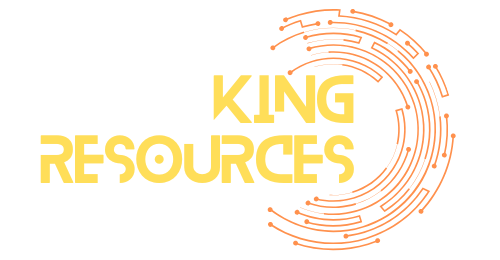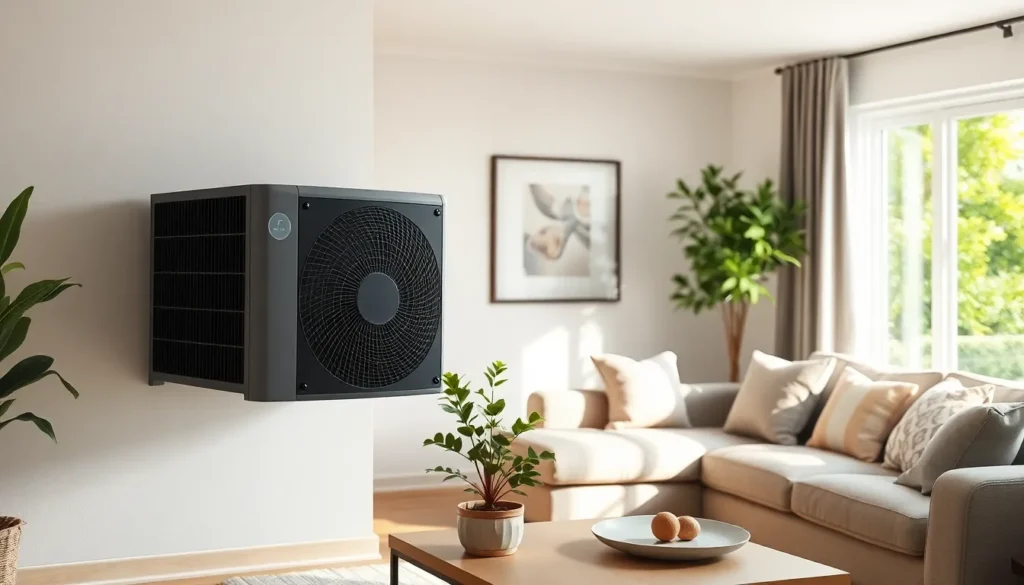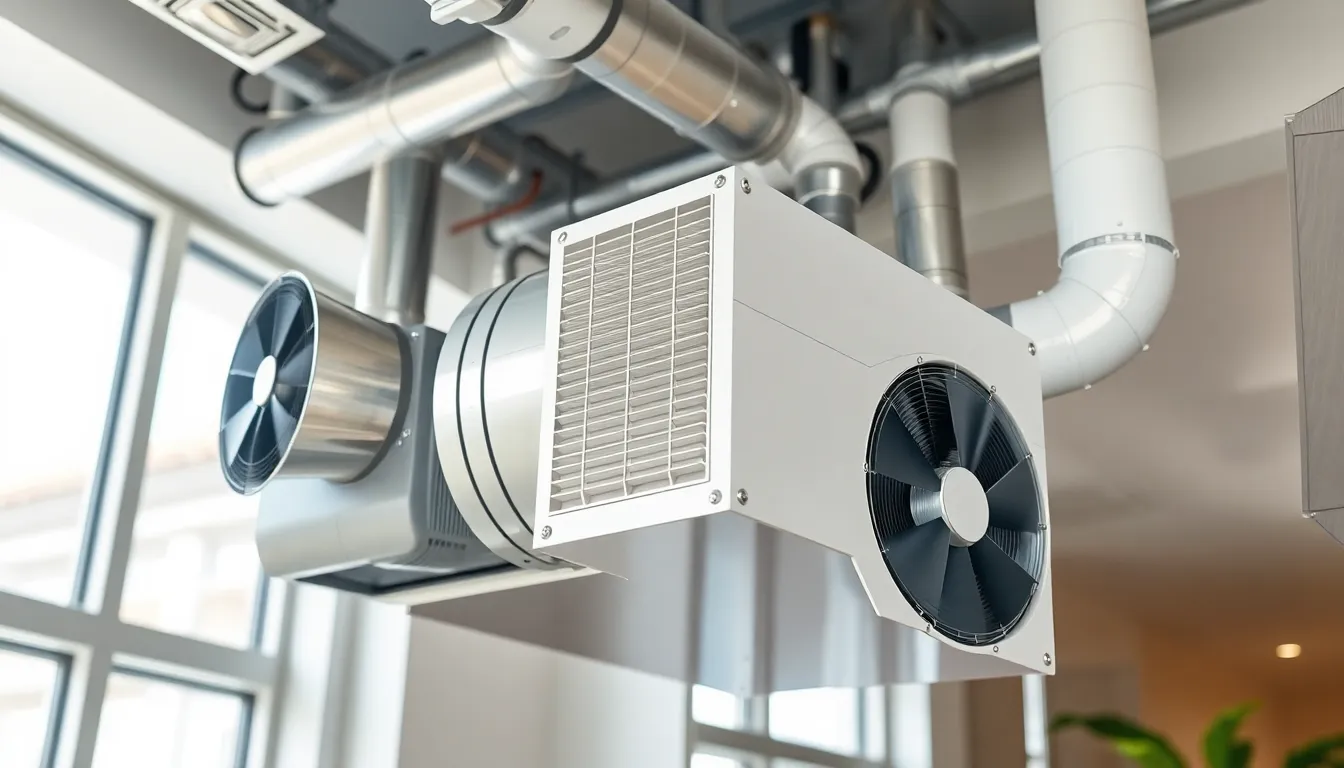In a world where energy efficiency reigns supreme, energy recovery ventilators (ERVs) are the unsung heroes of indoor air quality. Imagine a device that not only keeps your home fresh but also saves you money on energy bills. Sounds like magic, right? Well, it’s just science doing its thing—turning stale air into a breath of fresh air while recycling energy like a pro.
These clever gadgets work tirelessly behind the scenes, ensuring you enjoy optimal comfort without sacrificing efficiency. They’re like the personal trainers for your home’s ventilation system, pushing out the old air while bringing in the new, all while keeping your energy consumption in check. If you’ve ever wished for a home that feels as good as it looks, it’s time to consider how an ERV can transform your living space into an oasis of clean air and savings.
Table of Contents
ToggleOverview of Energy Recovery Ventilators
Energy recovery ventilators (ERVs) optimize indoor air quality and energy efficiency. These systems transfer heat and moisture between incoming and outgoing air streams. By doing so, they reduce the energy required for heating and cooling.
Homeowners benefit significantly from ERVs. They maintain comfortable indoor humidity levels, which enhances overall comfort. Additionally, these devices help filter allergens and pollutants found in stale air. When stale air is replaced with fresh outdoor air, the living environment improves dramatically.
Implementing ERVs leads to tangible cost savings. Energy expenses decrease as systems use less energy for temperature regulation. According to the U.S. Department of Energy, ERVs can save homeowners 10 to 30 percent on heating and cooling bills.
Systems operate quietly, allowing for seamless integration into residential spaces. Many models come equipped with advanced controls, permitting users to customize ventilation rates. These features ensure optimal performance based on specific environmental needs.
Choosing an ERV requires careful consideration of various factors. Home size, climate, and specific air quality requirements influence the selection process. Consulting with HVAC professionals helps homeowners make informed decisions that align with their needs.
Energy recovery ventilators serve as effective tools for enhancing air quality and reducing energy costs. Investing in an ERV ensures that living spaces remain healthy, comfortable, and energy-efficient.
How Energy Recovery Ventilators Work
Energy recovery ventilators (ERVs) enhance indoor air quality while improving energy efficiency. These systems efficiently exchange stale air with fresh air, benefiting homeowners by maintaining comfort and reducing costs.
Core Components
ERV systems consist of several essential components. A heat exchanger plays a vital role in transferring thermal energy between incoming and outgoing air. Fans circulate air throughout the home, and filters trap allergens and pollutants. Ductwork connects various parts of the system, ensuring proper airflow. An integrated control panel allows customization of ventilation rates to match individual needs. These components work together to optimize energy recovery and indoor air quality, making ERVs effective and efficient solutions.
Operation Mechanism
During operation, incoming and outgoing air flows through the heat exchanger, facilitating heat and moisture transfer without direct contact. Fresh air enters the system while stale air exits, minimizing energy loss. When outdoor air enters, it absorbs heat from the outgoing internal air, reducing the energy required for heating or cooling. This process makes it easier to maintain comfortable indoor temperatures. ERVs also balance humidity levels, creating a more pleasant living environment while promoting energy efficiency. The systems operate quietly, which enhances the overall comfort in the home.
Benefits of Energy Recovery Ventilators
Energy recovery ventilators (ERVs) offer various advantages that enhance indoor air quality, boost energy efficiency, and lead to significant cost savings. These devices make a positive impact on home environments.
Improved Indoor Air Quality
ERVs enhance indoor air quality by continuously exchanging stale air with fresh outdoor air. Filters in these systems capture allergens and pollutants, providing cleaner air for occupants. Comfortable humidity levels are also maintained, reducing the chance of mold and mildew growth. By balancing moisture levels, these systems prevent excess humidity from affecting indoor environments. Improved air quality contributes to better health and comfort, allowing occupants to breathe easier.
Energy Efficiency
Energy recovery ventilators operate efficiently by reducing energy loss during air exchanges. They transfer heat and moisture between incoming and outgoing air streams, minimizing the energy needed for heating and cooling. This process enables homes to maintain comfortable temperatures with lower energy consumption. According to the U.S. Department of Energy, ERVs can provide substantial efficiency gains, leading to up to 30 percent less energy usage compared to traditional ventilation systems. Overall, these devices optimize heating and cooling efforts, supporting enhanced energy efficiency.
Cost Savings
Investing in energy recovery ventilators leads to considerable cost savings on utility bills. Homeowners often see a reduction of 10 to 30 percent in heating and cooling expenses after installing ERVs. By decreasing the workload on HVAC systems, these devices prolong their lifespan and reduce maintenance costs. Lower energy consumption translates to smaller energy bills each month. As more fresh air enters without significant energy loss, occupants enjoy a comfortable living environment while saving money.
Key Considerations When Choosing Energy Recovery Ventilators
Selecting the right energy recovery ventilator (ERV) involves key considerations that impact performance and efficiency. Attention to size and capacity, as well as maintenance requirements, proves essential for optimal functionality.
Sizing and Capacity
Determining the appropriate size for an ERV is crucial. An undersized unit struggles to provide adequate ventilation, while an oversized model may cycle on and off frequently, decreasing efficiency. The specific airflow needed for the space, measured in cubic feet per minute (CFM), directly correlates with the home’s occupancy and square footage. Homeowners should consult with professionals to calculate the required CFM and select a model accordingly. Adhering to guidelines from the American Society of Heating, Refrigerating and Air-Conditioning Engineers ensures the right fit.
Maintenance Requirements
Regular maintenance ensures the longevity of energy recovery ventilators. Filter replacements typically occur every three to six months, depending on usage and air quality. Cleaning the heat exchanger helps maintain efficiency and air quality. Technicians recommend annual professional inspections to identify potential issues and optimize performance. A focus on maintenance not only prolongs system life but also enhances energy savings. Keeping the unit clean and properly functioning establishes a comfortable living environment for occupants.
Conclusion
Energy recovery ventilators are vital for homeowners seeking to improve indoor air quality and enhance energy efficiency. By effectively exchanging stale air for fresh air they create a healthier living environment while reducing energy costs. The benefits of ERVs extend beyond comfort; they filter out allergens and pollutants maintaining optimal humidity levels.
Investing in an ERV not only leads to significant savings on heating and cooling bills but also prolongs the lifespan of HVAC systems. With proper sizing and regular maintenance homeowners can maximize the performance and efficiency of these systems. Ultimately ERVs represent a smart choice for those looking to create a more sustainable and comfortable home.










